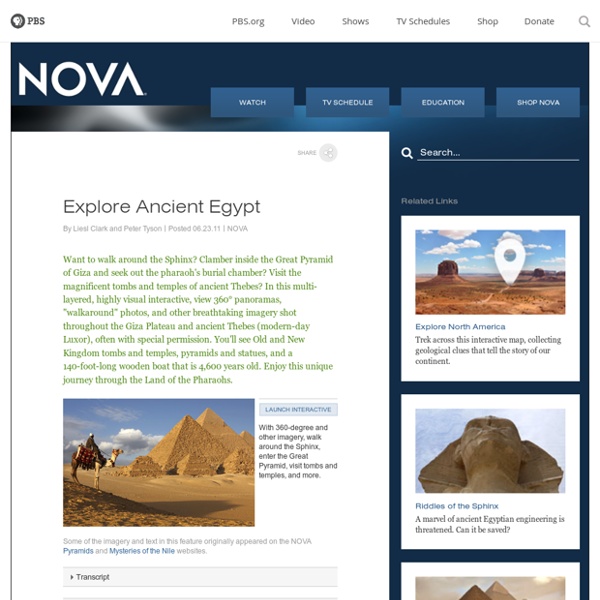King Tut Revealed
By A.R. Williams He was just a teenager when he died. The last heir of a powerful family that had ruled Egypt and its empire for centuries, he was laid to rest laden with gold and eventually forgotten.
Ancient Egypt - Ancient History
Under Ahmose I, the first king of the 18th dynasty, Egypt was once again reunited. During the 18th dynasty, Egypt restored its control over Nubia and began military campaigns in Palestine, clashing with other powers in the area such as the Mitannians and the Hittites. The country went on to establish the world’s first great empire, stretching from Nubia to the Euphrates River in Asia. In addition to powerful kings such as Amenhotep I (1546-1526 B.C.), Thutmose I (1525-1512 B.C.) and Amenhotep III (1417-1379 B.C.), the New Kingdom was notable for the role of royal women such as Queen Hatshepsut (1503-1482 B.C.), who began ruling as a regent for her young stepson (he later became Thutmose III, Egypt’s greatest military hero), but rose to wield all the powers of a pharaoh. All of the New Kingdom rulers (with the exception of Akhenaton) were laid to rest in deep, rock-cut tombs (not pyramids) in the Valley of the Kings, a burial site on the west bank of the Nile opposite Thebes.
How Were the Egyptian Pyramids Built?
No cameras were around thousands of years ago when the ancient Egyptians built the three pyramids of Giza, for each of three pharaohs Khufu, Khafre and Menkaure. And so scientists have had to piece together clues as to how these towering monuments were constructed. Over the past two decades, a series of new discoveries and studies allowed researchers to paint a clearer picture of those feats. [In Photos: Inside Egypt's Great Pyramids]
New clues illuminate mysteries of ancient Egyptian portraits
WASHINGTON — Scientists are getting a clearer picture of how ancient Egyptians painted lifelike portraits that were buried with mummies of the depicted individuals. These paintings sharply departed from Egyptians’ previous, simpler artworks and were among the first examples of modern Western portraits, archaeologist and materials scientist Marc Walton reported February 14 at the annual meeting of the American Association for the Advancement of Science. The “mummy portraits” date to more than 2,000 years ago, when the Roman Empire controlled Egypt. Three such portraits of Roman-era Egyptians, found more than a century ago at site called Tebtunis, were created by the same artist, said Walton, of Northwestern University in Evanston, Ill. Identities of the boy and two men in the portraits are unknown.
Carnegie Museum of Natural History: Life in Ancient Egypt
Life in Ancient Egypt Welcome to Life in Ancient Egypt, a companion online exhibition to Walton Hall of Ancient Egypt at Carnegie Museum of Natural History. Carnegie Museum of Natural History has acquired Egyptian artifacts since its founding and now holds about twenty-five-hundred ancient Egyptian artifacts.
Egypt Tourism Authority
Prepare to be blown away by the magnificence of these temples. They are undisputedly one of the world's most breathtaking monuments, and Egypt’s second most visited touristic site, the Pyramids of Giza being on the top of the list. The relocation of the temples was a historic event in the 1960's. At that time, the temples were threatened by submersion in Lake Nasser when the High Dam was constructed. The Egyptian government with the support of UNESCO launched a world wide appeal to save these colossal landmarks.
Egyptian Mummies
The methods of embalming, or treating the dead body, that the ancient Egyptians used is called mummification. Using special processes, the Egyptians removed all moisture from the body, leaving only a dried form that would not easily decay. It was important in their religion to preserve the dead body in as life-like a manner as possible. So successful were they that today we can view the mummified body of an Egyptian and have a good idea of what he or she looked like in life, 3000 years ago. Mummification was practiced throughout most of early Egyptian history.
Ancient Egypt
The tomb of King Tutankhamun was found almost entirely intact in 1922. This headdress, placed over the mummified head of the deceased king in 1343 B.C.E., is made entirely of gold. Hieroglyphics, pyramids, mummies, the Sphinx of Giza, King Tut, and Cleopatra. The sands of the Nile River Valley hold many clues about one of the most mysterious, progressive, and artistic ancient civilizations. A great deal of evidence survives about how the ancient Egyptians lived, but questions remain. Even the wise sphinx would have trouble answering some of them.
The Great Pyramid of Giza
Pyramids of Giza, soaring above the city of Cairo, Egypt The Great Pyramid of Giza is the most substantial ancient structure in the world - and the most mysterious. According to prevailing archaeological theory - and there is absolutely no evidence to confirm this idea - the three pyramids on the Giza plateau are funerary structures of three kings of the fourth dynasty (2575 to 2465 BC). The Great Pyramid, attributed to Khufu (Cheops) is on the right of the photograph, the pyramid attributed to Khafra (Chephren) next to it, and that of Menkaura (Mycerinus) the smallest of the three.
Egyptian Fractions
1 Egyptian Fractions The ancient Egyptians only used fractions of the form 1/n so any other fraction had to be represented as a sum of such unit fractions and, furthermore, all the unit fractions were different! Why? Is this a better system than our present day one?
Daily Life in Ancient Egypt
The daily life in ancient Egypt was actually much different than the vision that commonly comes to mind. Relics found in archaeological digs as well as paintings and drawings on pyramid and tomb walls depict images of life in ancient Egypt that was, in some regards, not that much different than life in Egypt today. Family Life



